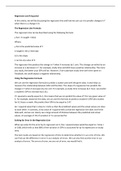College aantekeningen
Class notes Maths
- Vak
- Instelling
Regression analysis is a statistical method used to find the relationship between two or more variables. It helps us to understand how the value of one variable changes when there is a change in another variable. The regression line is a line that represents the relationship between two variables, ...
[Meer zien]




